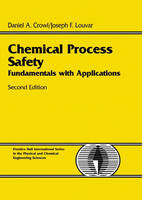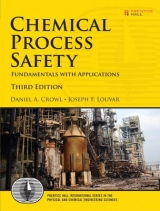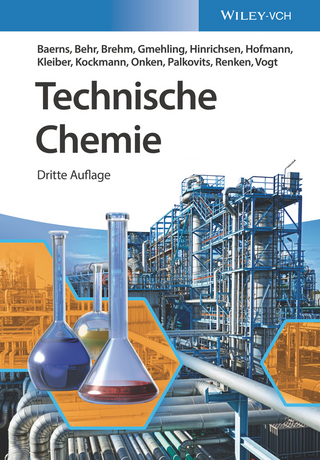
Chemical Process Safety
Prentice Hall (Verlag)
978-0-13-018176-3 (ISBN)
- Titel erscheint in neuer Auflage
- Artikel merken
Combines academic theory with practical industry experience
Updated to include the latest regulations and references
Covers hazard identification, risk assessment, and inherent safety
Case studies and problem sets enhance learning
Long-awaited revision of the industry best seller.
This fully revised second edition of Chemical Process Safety: Fundamentals with Applications combines rigorous academic methods with real-life industrial experience to create a unique resource for students and professionals alike.
The primary focus on technical fundamentals of chemical process safety provides a solid groundwork for understanding, with full coverage of both prevention and mitigation measures. Subjects include:
Toxicology and industrial hygiene
Vapor and liquid releases and dispersion modeling
Flammability characterization
Relief and explosion venting
In addition to an overview of government regulations, the book introduces the resources of the AICHE Center for Chemical Process Safety library. Guidelines are offered for hazard identification and risk assessment. The book concludes with case histories drawn directly from the authors' experience in the field.
A perfect reference for industry professionals, Chemical Process Safety: Fundamentals with Applications, Second Edition is also ideal for teaching at the graduate and senior undergraduate levels. Each chapter includes 30 problems, and a solutions manual is now available for instructors.
Daniel A. Crowl is the Herbert H. Dow Professor for Chemical Process Safety at Michigan Technological University. The author of numerous books and instructional materials on process safety, he also serves on several committees of the AICHE/CCPS. Joseph F. Louvar retired as director of BASF's Chemical Engineering Department to become a professor at Wayne State University, specializing in chemical process safety, risk assessment, and the design of experiments. He has authored many publications on process safety and chairs the Undergraduate Education Committee of the CCPS.
(NOTE: Each chapter concludes with a Suggested Reading and Problems.)
Preface.
Nomenclature.
1. Introduction.
Safety Programs. Engineering Ethics. Accident and Loss Statistics. Acceptable Risk. Public Perceptions. The Nature of the Accident Process. Inherent Safety. Four Significant Disasters.
2. Toxicology.
How Toxicants Enter Biological Organisms. How Toxicants Are Eliminated from Biological Organisms. Effects of Toxicants on Biological Organisms. Toxicological Studies. Dose versus Response. Models for Dose and Response Curves. Relative Toxicity. Threshold Limit Values.
3. Industrial Hygiene.
Government Regulations. Industrial Hygiene: Identification. Industrial Hygiene: Evaluation. Industrial Hygiene: Control.
4. Source Models.
Introduction to Source Models. Flow of Liquid through a Hole. Flow of Liquid through a Hole in a Tank. Flow of Liquids through Pipes. Flow of Vapor through Holes. Flow of Gases through Pipes. Flashing Liquids. Liquid Pool Evaporation or Boiling. Realistic and Worst-Case Releases. Conservative Analysis.
5. Toxic Release and Dispersion Models.
Parameters Affecting Dispersion. Neutrally Buoyant Dispersion Models. Dense Gas Dispersion. Toxic Effect Criteria. Effect of Release Momentum and Buoyancy. Release Mitigation.
6. Fires and Explosions.
The Fire Triangle. Distinction between Fires and Explosions. Definitions. Flammability Characteristics of Liquids and Vapors. Limiting Oxygen Concentration and Inerting. Flammability Diagram. Ignition Energy. Autoignition. Auto-Oxidation. Adiabatic Compression. Ignition Sources. Sprays and Mists. Explosions.
7. Designs to Prevent Fires and Explosions.
Inerting. Static Electricity. Controlling Static Electricity. Explosion-Proof Equipment and Instruments. Ventilation. Sprinkler Systems. Miscellaneous Designs for Preventing Fires and Explosions.
8. Introduction to Reliefs.
Relief Concepts. Definitions. Location of Reliefs. Relief Types. Relief Scenarios. Data for Sizing Reliefs. Relief Systems.
9. Relief Sizing.
Conventional Spring-Operated Reliefs in Liquid Service. Conventional Spring-Operated Reliefs in Vapor or Gas Service. Rupture Disc Reliefs in Liquid Service. Rupture Disc Reliefs in Vapor or Gas Service. Two-Phase Flow during Runaway Reaction Relief. Deflagration Venting for Dust and Vapor Explosions. Venting for Fires External to Process Vessels. Reliefs for Thermal Expansion of Process Fluids.
10. Hazards Identification.
Process Hazards Checklists. Hazards Surveys. Hazards and Operability Studies. Safety Reviews. Other Methods.
11. Risk Assessment.
Review of Probability Theory. Event Trees. Fault Trees. QRA and LOPA.
12. Accident Investigations.
Learning from Accidents. Layered Investigations. Investigation Process. Investigation Summary. Aids for Diagnosis. Aids for Recommendations.
13. Case Histories.
Static Electricity. Chemical Reactivity. System Designs. Procedures. Conclusion.
Appendix A: Unit Conversion Constants.
Appendix B: Flammability Data for Selected Hydrocarbons.
Appendix C: Detailed Equations for Flammability Diagrams.
Appendix D: Formal Safety Review Report for Example 10-4.
Appendix E: Saturation Vapor Pressure Data.
| Erscheint lt. Verlag | 29.10.2001 |
|---|---|
| Verlagsort | Upper Saddle River |
| Sprache | englisch |
| Maße | 185 x 236 mm |
| Gewicht | 1194 g |
| Themenwelt | Naturwissenschaften ► Chemie ► Technische Chemie |
| Technik ► Umwelttechnik / Biotechnologie | |
| Wirtschaft | |
| ISBN-10 | 0-13-018176-5 / 0130181765 |
| ISBN-13 | 978-0-13-018176-3 / 9780130181763 |
| Zustand | Neuware |
| Informationen gemäß Produktsicherheitsverordnung (GPSR) | |
| Haben Sie eine Frage zum Produkt? |
aus dem Bereich



